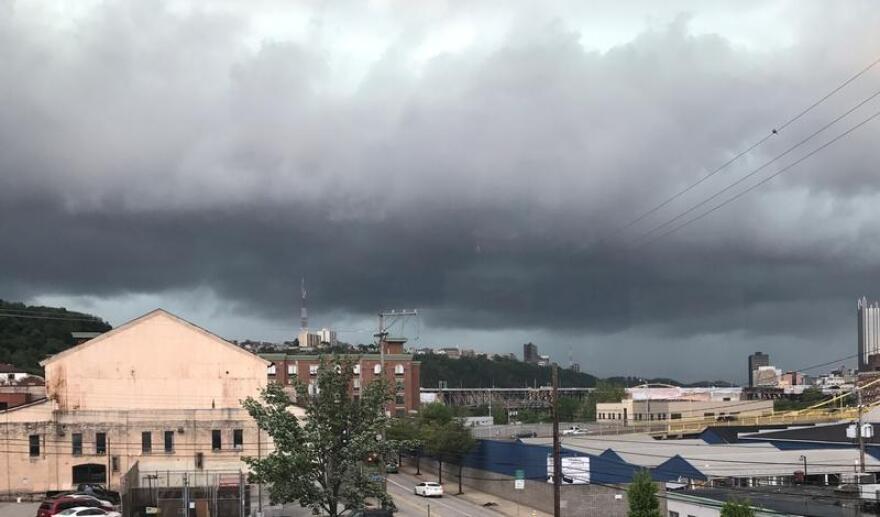On a recent Friday, Ross Mantle searched for the right angle to photograph a landslide site in Millvale. He adjusted the settings on his camera like a photographer from an old movie: his head under a sheet as he prepared his shot. Overhead, the sky was completely gray.
“So the one thing that’s nice about this kind of light is once you get your exposure down, once you kind of have your setup, you can work a little bit more quickly,” Mantle said.

The skies of Pittsburgh are often covered in a vast overcast of clouds. Those gray days made Good Question! listener Rod Tan ask, “Is it true Pittsburgh gets just as many cloudy and rainy days as Seattle?”
Pittsburgh sees its fair share of clouds, but it’s not quite as many as Seattle. According to the National Weather Service, Pittsburgh has an average of 203 cloudy days a year; Seattle gets closer to 226. But that still makes western Pennsylvania cloudier than the eastern side of the state.
Many of Pittsburgh’s clouds form about 130 miles north of the city near Lake Erie. Moisture from the lake fills the air and flows south. As the air cools, it also moves upward from around the elevation of 400 feet at the lake to above 1,300 feet in Pittsburgh.

“We here in Pittsburgh are in a situation that’s kind of ideal for having those clouds form,” according to Matthew Kramar, meteorologist at the Pittsburgh office of the National Weather Service. The combination of the lakes and upward-moving air means the Pittsburgh region sees lots of clouds, all the time.
Air that’s warmer than its environment is unstable. In order to stabilize, it moves upward. As it rises, it cools and produces stratocumulus clouds - the long, gray clouds that frequently fill the sky.
“Where there’s instability over a broader area, you end up with a good deal of cloud cover,” Kramar said. “Which is typically what we see here in the winter is almost a broken-to-overcast stratocumulus.”

The overcast days can have an affect on mental health, too. Kathryn Roecklein, an associate professor of psychology at the University of Pittsburgh, researches Seasonal Affective Disorder, also known as SAD.
“The only difference between SAD and the more typical depression we talk about is that we know SAD is going to start in the fall or winter, and spontaneously remit in the summer,” Roecklein said. She hasn’t done the research on the day-to-day causes of SAD, but Roecklein believes constant cloudiness can cause some of the same emotional effects.
“I do think that a string of cloudy days is associated with lower mood, lower energy, things like craving more carbohydrates - not wanting to be as social, not wanting to exercise or be as active as much - some of the typical symptoms of SAD.”
Even anticipating the oncoming symptoms of SAD can cause those lows to appear earlier, Roecklein said.
Roecklein says exercise, meeting up with friends and increased exposure to natural light can help boost moods when the sky is gray.
This is part of our Good Question! series where we investigate what you've always wondered about Pittsburgh, its people and its culture.
The cloud cover also impacts temperature. Daytime heat usually escapes through the atmosphere overnight. Clouds stop that air from escaping, keeping the weather warmer, said Kramar.
Photographers benefit from the cloud coverage, too. Clouds in the sky can offer different kinds of lighting to work with. The photographer Mantle looked at the muddy hillside in front of him.
“One thing that’s nice about this light is that you get an evenness to everything,” photographer Mantle said. “Everything kind of carries the same weight. You don’t have to think so much about shadows, and what that is exposing or covering up.”
Mantle took another look at the hill, then ducked his head under his sheet and snapped a picture.
_





